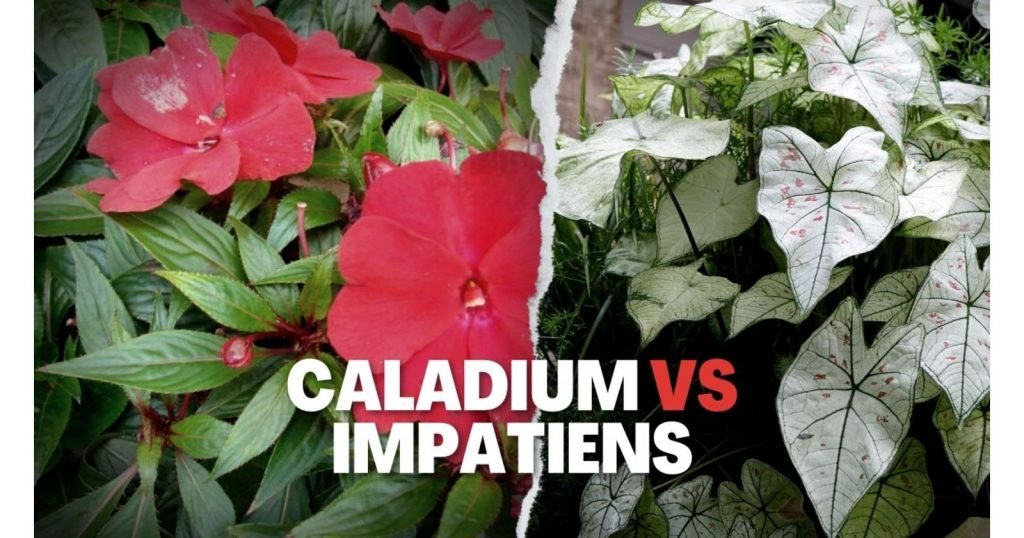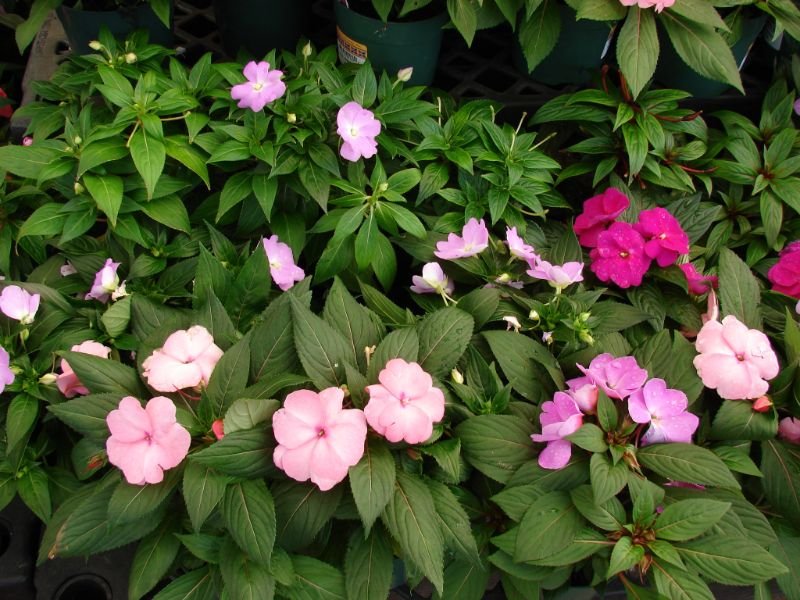Caladiums and impatiens are admired by many plant enthusiasts as houseplants that thrive well in shady garden beds. They are both beautiful in their way, however, choosing which one is more suitable for your landscape could be tricky.

As two whole different plants, impatiens and caladiums need contrasting maintenance in addition to their distinctive visuals. In this section, we gather all the things you need to know about these two gorgeous plants, so let’s check them out!
Table of Contents
Plant Zones
Impatiens hawkeri, also known as New Guinea impatiens or simply impatiens, is a perennial that mostly grows as an annual in many regions. They perform best in zones 10 through 11.

Caladium, which got nicknames for angel wings, fancy-leaved caladiums, or elephant’s ears, is typically grown as a perennial in warmer climates. This plant does well in zones 9 through 10. Caladiums and impatiens are similar when it comes to growing zones. These plants require warmer temperatures along with average minimum winter temperatures.

Country of Origin
Caladiums and impatiens came from different regions of the world. Impatiens’ native habitat ranges from New Guinea, and Solomon Island, to islands nearby, meanwhile caladiums originate from Central and Southern America.
Plant Size
Impatiens and caladiums are perfect for both indoor or outdoor houseplants, mainly because of their ease of maintenance and compact size. Nonetheless, some new varieties of these plants can thrive more massively than usual.
The average height of impatiens ranges from about 10 to 18 inches (25 to 45 centimeters) tall, with approximately 12 to 16 inches (30 to 40 centimeters) wide. On the other hand, caladiums thrive in a slightly bigger size, with an average height of 12 to 30 inches (30 to 76 centimeters) tall, and could spread more or less than 24 inches (60 centimeters).
Shape and Color Appearance

With proper care, healthy caladiums and impatiens will award gardeners with their spectacular and dazzling colors. Caladiums’ color spectrum ranges from shades of pink, shades of green, white, or dark, purplish-pink. Each variation has an eye-catching different mix of color and patterns. Their impressive foliage thrives in neither ruffled wings nor heart-shaped.
Impatiens also offer a wide range of vivid colors, from red, purple, and lavender, to shades of pink, white, orange, to yellowish-salmon. They feature ovate-shaped, dark green foliage with round, 4 to 5-petaled blossoms.
Flowers and Fruit Presence
Impatiens are flowering plants that attract most because of their delicate and stunning flower appearance. These flowers produce small, capsule-like fruits with a green or darker green that is not commonly used for consumption.
Otherwise, caladiums are mainly grown for their fantastic foliage color and shape. These plants produce arum-like flowers, with pale yellow spadix and spathe that seldom occur indoors. Caladiums mostly do not produce any fruits.
Impatiens and Caladiums Caring Guide Comparison
Blooming Season
Impatiens and caladiums do not share the same blooming season. Depending on the cultivar and growing conditions, impatiens usually bloom from early spring or late summer until fall. Caladiums, on the contrary, are not grown for their flowers, which usually bloom during summer. Gardeners can enjoy the attractive caladiums’ foliage throughout the growing season.
Light
Although differs in the blooming season, caladiums and impatiens have similar light requirements. Both plants prefer partial shade or filtered sunlight over direct light, which can scorch their delicate leaves and flowers. Some caladium varieties tolerate full sun but not for an extended period.
Watering
Both caladiums and impatiens prefer consistently moist, well-draining soil. These two are not fans of over-watering and under-watering. The general rule of thumb to water impatiens and caladiums is to water deeply when the top inch, about 2 inches or more, of topsoil feels dry. Make sure to allow the excess water to drain away.
Soil
For those with slightly acidic soil, both caladiums and impatiens may be suitable for you. These two need slightly acidic to neutral soil, with pH ranges from 5.5 to 6.5. Loamy or sandy soil with the high organic matter also is perfect for these two.
Temperature and Humidity
Caladiums and impatiens have similar, mostly warm temperature requirements. The minimum and maximum temperature for impatiens goes anywhere between 60°F to 80°F (15°C to 26°C). Caladiums love warmer conditions, where the minimum temperature for this plant is at least 70°F (21°C), and they can go as warm as 85°F (29°C). These two can’t say no to high humidity–yes, they love it! A humidity level between 50% to 90% is ideal for them.
Fertilizing
Caladiums and impatiens are considered heavy feeders and benefit from regular fertilizing during their growing season. Feed them fertilizers once every three to four weeks with balanced, water-soluble fertilizers that contain equal amounts of NPK (nitrogen, phosphorus, potassium). Stop feeding them fertilizers during fall.
Pruning, Propagating, and Repotting
The act of pruning and propagating impatiens and caladiums can help keep these plants not only healthy but also visually appealing. To prune impatiens, deadhead any diseased, wilting, or dead blooms to encourage new growth. Cut back leggy or overgrown stems for bushier growth. Unlike caladiums, impatiens can be propagated from stem cuttings.
Caladiums benefit from pruning, although most of the time not necessarily needed, to keep the plant healthy and prevent the spread of disease when the plants get infected. Alternately, the most recommended propagation method for caladiums is by tuber division. Repot both plants in the spring or early summer to provide more space to grow and prevent root bound, with a new mix of potting soil.
Common Problems
Under bad growing conditions, caladiums are vulnerable to fungal, bacterial, and pests diseases. This includes but is not limited to spider mites, aphids, leaf spots, and root rot. To address these problems, make sure to thrive under a proper growing environment and treat the problems using insecticide or neem oil if necessary.
Impatiens are susceptible to problems such as powdery mildew, root and crown rot, wilting flowers, stunted growth, and virus-related diseases. They can be treated by using a fungicide, insecticide, or neem oil, and the best solution to keep them away is by establishing a correct maintenance routine.
Dormancy
Unlike caladiums, impatiens are likely not to go into the dormancy phase during winter. However, they still are not fond of frost and cold temperatures. Caladiums enter their dormancy phase depending on your climate, but generally in the late summer or early fall.
FAQ
Do Caladiums and Impatiens Have Thorns?
No, caladiums and impatiens do not have thorns and are generally safe to handle without protective gloves or clothing.
Do Impatiens and Caladiums Fast-grower?
Caladiums and impatiens are not considered fast-growers, however, they can grow relatively quickly under the proper management.
Are Caladiums and Impatiens Poisonous?
Impatiens are generally safe for humans and pets, but sadly, we can’t say the same for caladiums. These aroids contain water-insoluble calcium oxalate crystals that can cause symptoms such as irritation, vomiting, and burning sensation if large quantities are eaten.
Caladiums vs Impatiens: So Which One Should I Grow and Why?
To conclude, caladiums and impatiens are both wonderful houseplants that are not that difficult to maintain and share numerous similarities. Depending on your taste and climate, if you’re more of a fan of flowering plants, you should go with impatiens. But if the foliage is more attractive to you, then caladiums may be the right answer.

New author in the hood. Loves gardening and flowers are my spirit animals (yes I know they are not animals but I insist). I will be covering most of the flowers’ topics here and occasionally random though as well.






